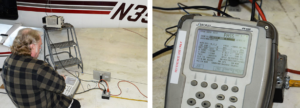By January 1, 2020, you must be equipped with ADS-B Out to fly in most controlled airspace. Federal Regulations 14 CFR91.225 and 14 CFR 91.227 contain the details.
ADS-B is transforming all segments of aviation. Real-time precision, shared situational awareness, advanced applications for pilots and controllers alike — these are the hallmarks of ADS-B NextGen surveillance.
- Real-time ADS-B is used now for air traffic control
- General aviation is safer with ADS-B traffic, weather, and flight-information services
- Safety and efficiency improve with advanced ADS-B applications
ADS-B improves safety and efficiency in the air and on runways, reduces costs, and lessens harmful effects on the environment.
An ADS-B Out transmitter alone is not sufficient to meet the requirements of 14 CFR 91.225 and 91.227. Aircraft must be equipped with a Version 2 ADS-B Out transmitter and a compatible GPS position source. There are two types of ADS-B systems available:
- Mode S transponder with Extended Squitter, referred to as 1090ESthat meets the performance requirements of Technical Standard Order TSO-C166b
- Universal Access Transceiver (UAT)that meets the performance requirements of TSO-C154c. UAT has the additional capability to receive weather data provided by the FAA ADS-B network and operates on 978 MHz.
The most important factor when considering which system to choose is the airspace in which you operate. For aircraft operating at and above Flight Level 180 you must be equipped with 1090ES. For aircraft operating below 18,000 feet mean sea level and within U.S. ADS-B-required airspace, you must be equipped with either 1090ES or UAT equipment. Note that outside the U.S., almost all ADS-B systems operate on 1090 MHz.
The FAA recommends a WAAS GPS that is compliant with TSO-C145 or TSO-C146. These units are readily available for general aviation and provide sufficient performance to meet the 14 CFR 91.227 requirements. Avionics vendors offer stand-alone GPS receivers and package them with ADS-B transmitters or with GPS Navigators. GPS and ADS-B transmitter pairings installed on Type Certificated aircraft require FAA approval. ADS-B Out systems marketed for installation on Experimental and Light Sport aircraft must have a 14 CFR 91.227 compliance statement from the applicable airframe and/or equipment manufacturer. Be sure to contact your manufacturer before installation if you are unsure of ADS-B Out system component compatibility.
The Installation Approval for ADS-B OUT Systems memo explains the FAA’s policy regarding installation of ADS-B Out systems into civil aircraft.
Getting the Installation Right
It’s important to know that incorrectly installed ADS-B equipment means that your aircraft does not comply with the ADS-B equipage rule. If you already have equipment installed, find out if your equipment is working properly. And if you’re ready to make your installation appointment, explore some of the things you should know when selecting a shop to do the installation work, learn about some common problems that can occur during the installation, and know what to expect before accepting an installation in this FAA Safety Briefing article.

ADS-B ground testing equipment, as shown here, can verify all parameters are correct after an ADS-B installation.
The FAA is working with operators, manufacturers, and installers on eliminating common ADS-B installation errors. The most common issues associated with an ADS-B installation are:
- Missing Barometric Pressure Altitude
- Air/Ground Determination Issues
- Flight ID issues including Missing Flight ID 3-letter identifier
- Duplicate & Wrong ICAOs
- Invalid Mode 3/A Code — Mitigation in place
- Incorrect Emitter Category
- Aircraft with Position Errors
For additional information, please read the technical paper (PDF) explaining the FAA’s policy regarding alterations to aircraft for the installation of ADS-B equipment.
FAA Field Approval Guidance
Current policy allows for field approvals under specific conditions. An update to this memo is in progress. To check if your installation complies with the rule, you can request:
- Compliance reportfor field approvals and post installation performance certification
- Certification reportfor certification of ADS-B systems per AC 20-165B section 4-3 a (1)



